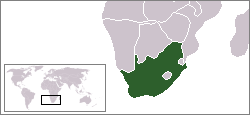Addo Elephant National Park
|
Addo Elephant National Park
|
|
| location | South Africa |
| surface | 1640 km² |
| Geographical location | 33 ° 27 ' S , 25 ° 45' E |
| Setup date | 1931 |
| administration | National Park Service |
The Addo Elephant National Park ( Afrikaans : Addo Olifant Nasionale Park , English : Addo Elephant National Park ) is located in the Sarah Baartman district , in the western part of the Eastern Cape Province in South Africa , 70 kilometers northeast of Port Elizabeth in the Sundays River Valley . With 1640 km², the Elephant National Park is the largest national park in the Eastern Cape.
history
The national park was established in 1931 to protect the eleven last surviving elephants in the region, who had not yet fallen victim to ivory hunters or farmers. The founding was preceded by a government-initiated hunt for the native Cape elephants, which repeatedly devastated the fields and gardens of the local farmers in search of food. After public protests broke out when the “last great white hunter” Major PJ Pretorius killed 130 elephants in one year, the game reserve, which has since been expanded several times, was established in the Addo bush. In 1954, when there were 22 elephants, then park manager Graham Armstrong had an area of 2,270 hectares surrounded with elephant fences. This fence is still used by the park today and is named as the "Armstrong fence" after its inventor.
In 2004 there were around 350 elephants in the park; In 2006 just over 400 elephants were counted. The national park thus achieved the ecologically acceptable maximum number of elephants.
In the long term, the Addo Elephant Park is to become the third largest park in South Africa. The park is to grow to a size of 3600 km².
Flora and fauna
In addition to elephants, the Addo Elephant National Park also has kudu , African buffalo , eland , South African hartebeest , bushbuck , warthog , plains zebra , black rhinoceros , hyenas and leopards . In some peripheral areas, for example in the area of the Darlington Dam or near the Zuurberg Mountains, there are also some ungulate species typical of the Cape area, such as mountain zebras , white-tailed wildebeest , oryx and springbok . Hippos live on the Sundays River . In 2003 lions were introduced to the park, so that the so-called Big Five can be found in the park since then . Spotted hyenas have also been introduced, and the reintroduction of wild dogs and cheetahs is also planned.
The national park is home to more than 500 different plant species from around 70 families. You will find mainly small plant species and various types of bush such as Schotia afra and Portulacaria afra .
tourism
The national park has around 120,000 visitors annually. The majority of the approximately 50 percent foreign visitors come from Germany , the Netherlands and the United Kingdom .
A warehouse was set up for visitors to the park. There is a swimming pool, a restaurant, an illuminated water hole and various accommodations. The main entrance and two visitor streets in the park are paved, while the others are covered with gravel. An additional access from the N2 motorway along the Garden Route leads to the roads for visitors.
Animals in the Addo Elephant National Park
Web links
- South African National Parks: Addo Elephant National Park . National park administration website at www.sanparks.org (English)
- W. Franke: The Addo Elephant Park in South Africa . on www.addoelephantpark.de (German)
Individual evidence
- ^ W. Franke: The flora in the Addo Elephant Park . on www.addoelephantpark.de









